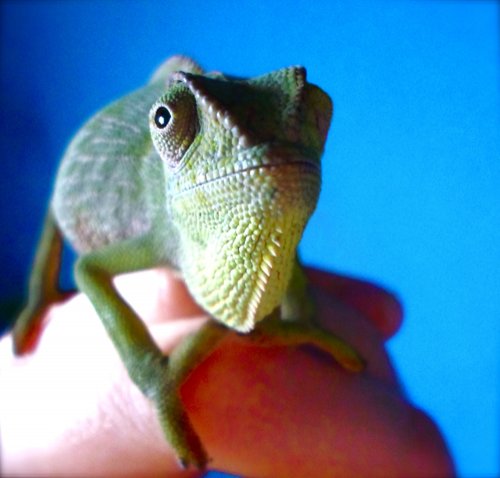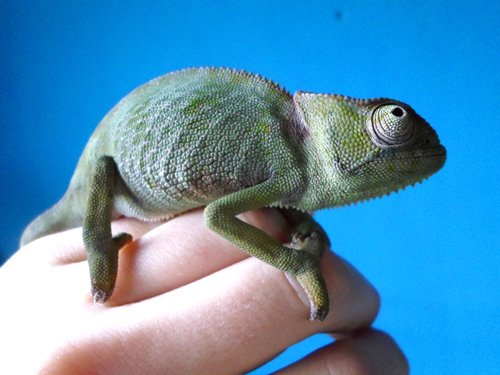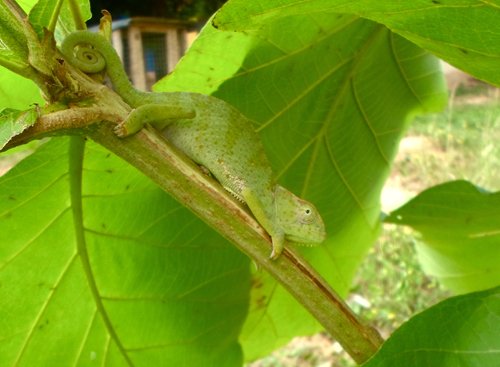jasminelee
New Member
Hello, my name is Jasmine and I am a US Peace Corps volunteer living in Ghana. I have some crucial and immediate questions for you, but I'd like to preface it with a quick background story about how I came to possess a wild chameleon here in Ghana.
Yesterday I was in a city called Sunyani (the regional capital of Ghana's Brong Ahafo region) and a guy on the street randomly called me over to his electronics shop and gave me a live chameleon in a box. This was around noon. I had a number of things to do in the city that day so I did only the most pressing errands as quickly as I could and then started the long bumpy journey back to my small rural village, arriving just before 7pm. At this time, I went into the bush by my house where I've seen other wild chameleons and set him free. Though by this point he was too stressed and tired to move, understandably. I tried giving him some water by putting his face into a small dish. When this was unsuccessful I tried using my hand to bring the water his mouth. He still wouldn't drink. I let him chill out there in the weeds and went to do other things, thinking he'd rest a bit and then scamper away. A few hours later I came back and found him the the same exact spot. I initially thought he was dead. He was very cold (it's a bit chilly in the evenings now during the dry season) and his eyes were closed. Afraid that he'd get too cold in his compromised state or succumb to predation, I took him inside with me. He eagerly climbed onto my warm hand. Inside, I tried again to give him water, this time endeavoring to pry open his mouth and give it to him manually with a needle-less syringe. I couldn't get his mouth open without causing him too much distress so I figured the best thing for him would be to rest. I let him climb onto a horizontal beam just under my ceiling that is covered in clothes and put a big cabbage leaf on top of the beam with water pooled in it. He clung to the clothes and slept there most of the night, eventually climbing up to the cabbage leaf. I don't know if he drank any water, but I assume so. Today he is looking better. His eyes are open and he's alert. He's been watching me all day. He's very docile and will sit wherever I put him. I tried feeding him bugs - alive and dead, but he didn't eat them. I set up a live tree branch in my room and he's now perched in that. I sprayed it with water so he could drink off of the leaves like they do in the wild. He looks pretty thin - his ribs are visible - so I'd like to get him healthier before trying to release him again.
Can anyone give me some advice as to how to care for him? I don't know how to get him to eat, or if he's getting enough water. I don't have a way to keep him warm either but since he's wild I imagine he is fine with this environment. I have never owned a chameleon before, though I've had other reptiles and I love all animals dearly. Any advice would be very much appreciated. Thank you!
P.S. I'm not sure what species he is. I have some photos of him but I don't know how to post them on here.
S.P.S. I've named him Irving (after Washington Irving, the American writer who wrote Rip Van Winkle and Sleepy Hollow).
Yesterday I was in a city called Sunyani (the regional capital of Ghana's Brong Ahafo region) and a guy on the street randomly called me over to his electronics shop and gave me a live chameleon in a box. This was around noon. I had a number of things to do in the city that day so I did only the most pressing errands as quickly as I could and then started the long bumpy journey back to my small rural village, arriving just before 7pm. At this time, I went into the bush by my house where I've seen other wild chameleons and set him free. Though by this point he was too stressed and tired to move, understandably. I tried giving him some water by putting his face into a small dish. When this was unsuccessful I tried using my hand to bring the water his mouth. He still wouldn't drink. I let him chill out there in the weeds and went to do other things, thinking he'd rest a bit and then scamper away. A few hours later I came back and found him the the same exact spot. I initially thought he was dead. He was very cold (it's a bit chilly in the evenings now during the dry season) and his eyes were closed. Afraid that he'd get too cold in his compromised state or succumb to predation, I took him inside with me. He eagerly climbed onto my warm hand. Inside, I tried again to give him water, this time endeavoring to pry open his mouth and give it to him manually with a needle-less syringe. I couldn't get his mouth open without causing him too much distress so I figured the best thing for him would be to rest. I let him climb onto a horizontal beam just under my ceiling that is covered in clothes and put a big cabbage leaf on top of the beam with water pooled in it. He clung to the clothes and slept there most of the night, eventually climbing up to the cabbage leaf. I don't know if he drank any water, but I assume so. Today he is looking better. His eyes are open and he's alert. He's been watching me all day. He's very docile and will sit wherever I put him. I tried feeding him bugs - alive and dead, but he didn't eat them. I set up a live tree branch in my room and he's now perched in that. I sprayed it with water so he could drink off of the leaves like they do in the wild. He looks pretty thin - his ribs are visible - so I'd like to get him healthier before trying to release him again.
Can anyone give me some advice as to how to care for him? I don't know how to get him to eat, or if he's getting enough water. I don't have a way to keep him warm either but since he's wild I imagine he is fine with this environment. I have never owned a chameleon before, though I've had other reptiles and I love all animals dearly. Any advice would be very much appreciated. Thank you!
P.S. I'm not sure what species he is. I have some photos of him but I don't know how to post them on here.
S.P.S. I've named him Irving (after Washington Irving, the American writer who wrote Rip Van Winkle and Sleepy Hollow).







